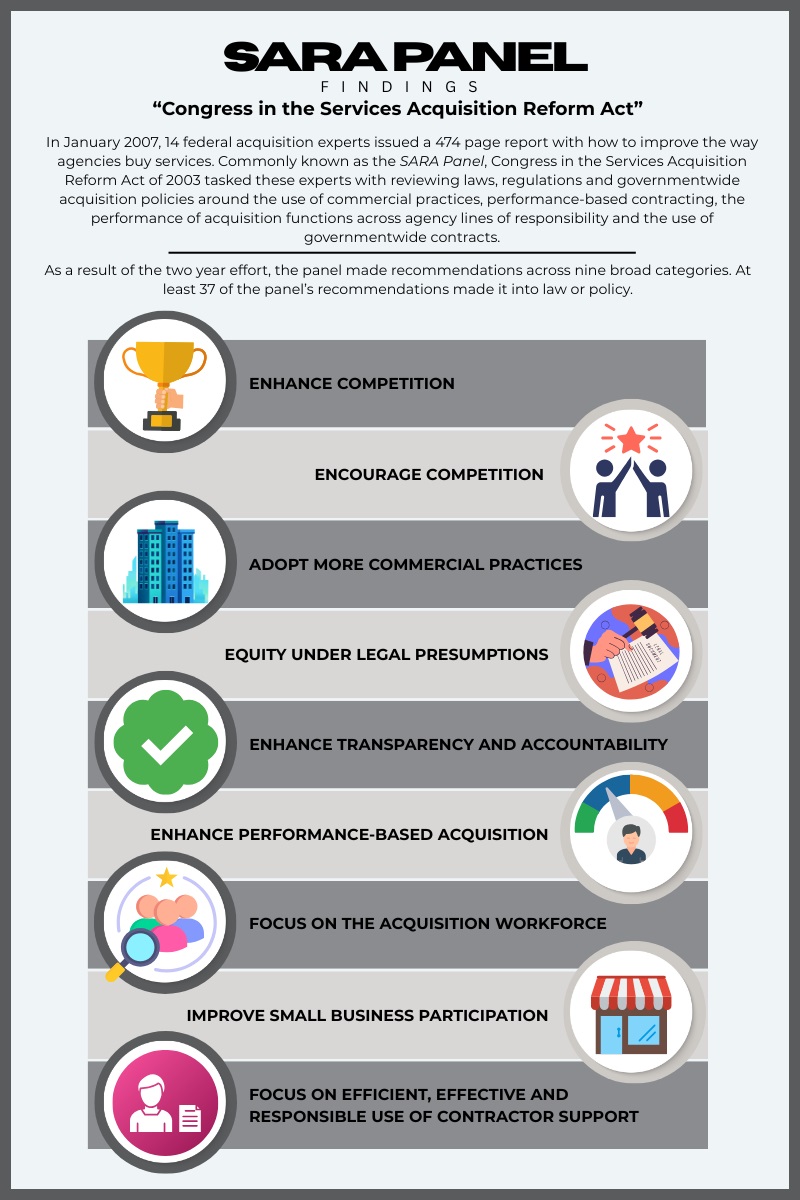| What: | The Services Acquisition Reform Act (SARA) |
| When: | Congress passed and President George W. Bush signed the bill into law in November 2003. |
| Why it matters: | SARA established agency chief acquisition officers, the Chief Acquisition Officer’s Council and created a centralized funding source for civilian agency acquisition training. It also promoted the use of performance-based contracting and emphasized the need for agencies to buy commercial services. |
Politics
The law that set the foundation for modern acquisition


The fallout from the so-called “peace dividend” from the end of the Cold War came to a head in the early 2000s.
The signs were all around. Agencies were losing too many bid protests because too many experienced acquisition workers left federal service in the late 1990s. The remaining members of the acquisition workforce were struggling.
The Global War on Terror led agencies to lean too much on private sector contractors and the line between inherently governmental and what agencies could contract out became blurred.
The Clinton administration’s reinventing government initiative ushered in the use of multiple award and governmentwide acquisition type contracts that both gave agencies more control over their acquisition programs, but also resulted in inconsistencies and variabilities in the training of contracting officers and the application of acquisition rules and regulations.
Finally, the buying patterns of agencies finally tilted with departments spending more money on services than products for the first time ever. In fiscal 2002, agencies spent $135 billion out of the government’s $200 billion procurement budget on services, which was a 24% increase since 1990.
By fiscal 2024, the Government Accountability Office said agencies spent $755.1 billion on federal procurement with $496 billion, or 65%, for services.
The solution to these and other problems was the Services Acquisition Reform Act (SARA).
 Former Virginia Congressman Tom Davis (R) was the author of SARA.
Former Virginia Congressman Tom Davis (R) was the author of SARA.
“We saw an opportunity and could get congressional support for some areas that I think there was widespread agreement needed to be changed,” said former Rep. Tom Davis (R-Va.), the author of the legislation, and now a partner with Holland & Knight, in an interview with Federal News Network. “One was the training of the acquisition staff. Government was losing too many protests. There was just a lot of sloppiness going into writing some of these procurements and then they were getting overturned. That doesn’t help anybody. So we said, look, we need to spend some time, some effort and some money on training our acquisition workforce. Secondly, just to share ideas, we set up this Chief Acquisition Officers Council, where they could sit, talk and compare notes. You could get the macro trends and nip any problems in the bud. We brought some flexibility into hiring, which we thought was very, very important, in getting people in there. Then on the acquisition side, we loosened that up a little bit, and then we moved to something called performance-based contracting. Then, as now, it’s a continuing problem, the cost-plus type contracts seems to be the preferred contracting vehicle, and the government was losing a lot of money, partly because the government didn’t know what they wanted.”
Congress passed SARA as part of the National Defense Authorization Act for Fiscal Year 2004 and President George W. Bush signed the bill into law in November 2003.
Davis and other federal acquisition experts say the law elevated the idea of acquisition and its associated workforce beyond just contracting officers, and also incorporated program managers, contracting officer technical representatives and program managers into the broader discussion. SARA provided a consistent funding stream for acquisition workforce training. And, it attempted to give agencies more discretion for how to buy commercial services, using an assortment of contract types.
“There was a recognition by the time SARA came along, that we really needed to reinforce and strengthen our foundation for buying services,” said Matthew Blum, the deputy administrator in the Office of Federal Procurement Policy. “I think in that regard, it really gave our workforce access to more sophisticated training and development programs. We have better access to resources. I think our senior leaders are honestly better positioned to align contracting with good program results.”
Additionally, the law led to the SARA panel, which brought together a group of public and private sector experts to provide recommendations to Congress and the Bush administration for how to further improve services acquisition.
The resulting 474-page report in 2007, four years after the bill became law, highlighted ideas and concepts that not only are relevant today, but drove changes that four administrations have picked up like category management, contract consolidation and the need for better data to drive acquisition decisions.
 Graphic by: Derace Lauderdale
Graphic by: Derace Lauderdale
Lesley Field, the long-time deputy administrator of OFPP, who retired in December after 24 years at the Office of Management and Budget, said while SARA provided a lot of positive outcomes, the funding of acquisition workforce training for civilian agencies probably was the most important part of the act.
She said before SARA, agencies didn’t have a consistent stream of funding nor did they have a centralized place to train their contracting officers and others.
“It drove greater professionalization for hundreds of thousands of acquisition workforce members. It established the Workforce Training Fund, and I can’t overemphasize how important that was in developing a highly skilled professional workforce in civilian agencies,” Field said. “DoD had the Defense Acquisition Workforce Improvement Act that gave them a lot of strength, a lot of structure, and it gave them funding. They had the Defense Acquisition University. We did not. But the importance of Congress saying at the time that the acquisition function and the people hired to execute it were critical to mission was everything. It gave us the platform to develop the qualification standards for the contracting officers and others, the Federal Acquisition Certification Program in Contracting (FAC-C) and all of that. It provided support to the Federal Acquisition Institute, and it gave us a common workforce management system or two, and eventually achieved parity with DoD in 2023. That all stemmed from SARA.”
Field said the acquisition training fund, which pulled funding from the fees the General Services Administration charged agencies for using their governmentwide acquisition contracts, grew from $5 million in 2004 to more than $20 million today.
She said SARA paved the way for OFPP to establish common requirements for the training of the acquisition workforce, which further led to a multitude of certification programs for contracting officers, program managers, COTRs and eventually the Digital IT Acquisition Professional (DITAP) program.
“It gave us direct hire authority, which acknowledged the need to bring on board those skilled and talented employees, and it amplified the importance of this workforce, which I will continue to say is one of the most well trained, highly skilled workforces in government. These folks will still be needed to support mission delivery, no matter what,” she said.
Just as important, SARA established the role of chief acquisition officer (CAO) at all agencies and created the CAO Council.
OFPP’s Blum said the CAO and council was critical to making the procurement community an equal player with all of the other management functions. It also helped further recognize that acquisitions are directly intertwined with mission performance.
“We’ve always had some type of affinity group that brought our community together. But I think having a CAO Council and getting that fresh start as a critical convening forum to solve problems and promote consistency around best practices, has been important,” he said. “The CAO Council operates a little bit differently, but we have definitely leveraged them to support and advance important governmentwide objectives. For example, they sponsored the Periodic Table of Acquisition Innovations, which has been instrumental to our cultural journey and creating an innovation friendly acquisition environment. There really were a lot of different dimensions to SARA that really were helpful in a foundation that we still are reliant upon and building on today.”
SARA Panel highlighted industry best practices
The third major pillar of SARA was using commercial best practices and performance-based contracting to help agencies overcome challenges in developing requirements.
Experts say this remains one of the biggest problems for the federal government.
Roger Waldron, the president of the Coalition for Common Sense in Government Procurement, a former GSA acquisition official and member of the SARA Panel, said the SARA Act tried to help agencies better understand what services fall within the definition of a commercial item.
“In the late 1990s and into the early 2000s…you could see the growth in the GSA schedules program and the addition of professional IT services on the schedule. It became the driver of growth for the schedules program,” Waldron, who hosts Off the Shelf on Federal News Network. “It was through the acquisition reform during the Clinton administration as well, and the creation of commercial item contracting, that really began all these debates about what is a commercial item under the statutory definition? Is it too loose? What about this of a type language? All those kind of things were going on.”
By the time the SARA Panel formed, buying commercial items remained a struggle for most agencies.
“A lot of it was assessing what’s going on in the commercial market in terms of the acquisition of services, and what can be learned from that? What are things that government could do to improve the acquisition of services, save money, get better performance and those kind of things,” he said. “There’s a chapter on performance-based contracting, or what we now call outcome-based contracting. It’s an approach that was used commercially. What is the result you want? Don’t dictate how you have to do it, but have the outcome you want to achieve and allow the company to come up with a solution.”
Laura Auletta, who spent 30 years in government working as a senior executive at GSA and the Homeland Security Department as well as serving as chairwoman of the Civilian Acquisition Council, said the SARA Panel heard from several multi-national companies like Disney, Proctor and Gamble and General Electric, about how they bought commercial services as part of the panel’s 7,500 pages of testimony.
Auletta, who served as executive director of the panel’s staff, said the SARA Panel found it fascinating to hear the emphasis, the time and the resources these companies place on front end of acquisition planning and defining their requirements.
“That is the place where we are always rushing to release a solicitation. That’s always because we don’t have enough lead time. We’re always pushing,” Auletta said. “Another kind of interesting or ‘a-ha’ moment is the funding cycles, or as we called it the spaghetti chart, because, honestly, it’s just all over the place in terms of agencies funding cycles and when they get the funding and how they can’t plan in that environment. I think that’s the other issue, this funding cycle, which has remained, continues to be a problem, has actually gotten, I think, a lot worse.”
Auletta said 37 of the SARA Panel’s recommendations actually passed through legislation or were put into acquisition regulations.
Performance-based contracting remains a struggle
Despite the progress with the law’s implementation and the panel’s recommendations making headway into law and regulations, experts say agencies still have a lot of opportunities to improve how they buy services.
The Trump administration’s push for more outcome-based contracts is an example of where the implementation of SARA’s provisions fell short.
Blum said too often agencies are only doing performance-based contracting in name, but the actual requirements are prescriptive.
Additionally, Blum said President Trump’s executive order from April to emphasize the requirement to buy commercial services and products is another example of where the intent of the SARA Act continues to fall short.
“When we look at the Federal Procurement Data System (FPDS), we see a large number of large contracts for what, on the surface at least, seem to be for common commercial services, like program management consulting, other professional services support that are being acquired as a non-commercial service using cost reimbursement contracts that are not performance based and more than likely are increasing the government’s exposure to risk,” he said. “This seems to go in the opposite direction of SARA and the incentives that it created to promote more fixed price contracting and the use of commercial buying procedures”
Despite the remaining challenges in services buying, experts agree the impact of the SARA Act is clear, even 20 years later.
“What I think is most interesting is I think SARA was trying to have us reduce the uniqueness of government requirements and processes,” Field said. “It directed us to look at more commercial practices, maybe to develop a better understanding of the market and to come to the table with that information. I think it set the scene for us to start the work on category management and to focus on commercial-based market research practices and data and all of the things that we did with category management. It was really to move to a more industry-like structure, so that we were taking advantage of what commercial industry could offer us, especially on common services, of course, and goods as well, but I think that was extremely important.”
The post The law that set the foundation for modern acquisition first appeared on Federal News Network.
Politics
Black Lives Matter Activist in Boston Pleads Guilty to Federal Fraud Charges – Scammed Donors to Fund Her Lifestyle

Screencap of YouTube video.
A Black Lives Matter activist in Boston named Monica Cannon-Grant pleaded guilty to federal charges this week, admitting that she scammed donors and used their money to fund her own lavish lifestyle.
Cannon-Grant was previously held up as an admired figure. The city of Boston named her the Bostonian of the year at one point for her ‘social justice activism’ and she was even recognized by the Boston Celtics basketball team for her efforts.
She is now facing a minimum of two years in prison.
The New York Post reports:
BLM-linked activist admits conning donors to fund her lavish lifestyle
A once-celebrated Boston social activist has pleaded guilty to defrauding donors — including Black Lives Matter — out of thousands of dollars that she used as a personal piggy bank.
Monica Cannon-Grant, 44, pleaded guilty Monday to 18 counts of fraud-related crimes that she committed with her late husband while operating their Violence in Boston (VIB) activists group, according to the US Attorney’s Office in Massachusetts.
The activist scammed money — including $3,000 from a BLM group — while claiming it was to help feed children and run protests like one in 2020 over the murder of George Floyd and police violence.
Cannon-Grant also conned her way into getting $100,000 in federal pandemic-related unemployment benefits — which she used to pay off her personal auto loan and car insurance policy.
But she has now confessed to transferring funds to personal bank accounts to pay for rent, shopping sprees, delivery meals, visits to a nail salon — and even a summer vacation to Maryland.
Just amazing.
Monica Cannon-Grant stole from donors, scammed the government, and lived it up while preaching about oppression. BLM grift is the only nonprofit where fraud is part of the mission statement. https://t.co/ir3q9lqYrh
— Matthew Newgarden (@a_newgarden) September 23, 2025
BREAKING: BLM activist Monica Cannon-Grant pleads guilty to 27 fraud charges, misusing over $1M from Violence in Boston for personal gain. Echoes Sir Maejor Page’s $450K scam conviction. A wake-up call for nonprofit accountability. pic.twitter.com/N9vvD369gB
— (@pr0ud_americans) September 14, 2025
Here’s a local video report:
She should pay back every penny.
The post Black Lives Matter Activist in Boston Pleads Guilty to Federal Fraud Charges – Scammed Donors to Fund Her Lifestyle appeared first on The Gateway Pundit.
Politics
Keith Olbermann Backpedals Furiously With Apology for Threatening CNN’s Scott Jennings – Jennings Responds (VIDEO)

As the Gateway Pundit reported yesterday, former MSNBC host and generally unhinged leftist Keith Olbermann, appeared to threaten CNN’s conservative pundit Scott Jennings on Twitter saying, ‘You’re next motherf**ker.’
Well, Olbermann may have gotten a phone call or a visit from the FBI because today he walked back those comments with a full-throated apology.
RedState has an update:
To quickly recap, Scott Jennings, a Salem Media Network radio host and conservative CNN political commentator, reacted to breaking news on Monday that Kimmel had been reinstated by tweeting, “So basically his employer suspended him for being an insensitive pr**k, and we don’t live in an authoritarian regime? Got it.”
This enraged Olbermann, who proceeded to tweet what many, including Jennings, perceived to be a threat. “You’re next, motherf**ker. But keep mugging to the camera.” Jennings tagged Patel and included a screengrab of the tweets in response.
Though the FBI hasn’t commented as to whether an investigation was launched, Olbermann ostensibly appears to have thought twice about what he tweeted and deleted, apologizing profusely in tweets posted on Tuesday and claiming what he wrote was “misinterpreted”:
See Olbermann’s tweet below:
I apologize without reservation to @ScottJenningsKY
Yesterday I wrote and immediately deleted 2 responses to him about Kimmel because they could be misinterpreted as a threat to anything besides his career. I immediately replaced them with ones specifying what I actually meant. pic.twitter.com/SPWLb73nEk
— Keith Olbermann (@KeithOlbermann) September 23, 2025
I oppose and condemn political violence, and the threat of it. All times are the wrong time to leave even an inadvertent impression of it – but this time is especially wrong
I should've acknowledged the deletion and apologized yesterday. I'm sorry I delayed.
— Keith Olbermann (@KeithOlbermann) September 23, 2025
Scott Jennings, always a class act, offered this hilarious response:
SCOTT JENNINGS: “Marking myself SAFE from that NUT, Keith Olbermann!” pic.twitter.com/EYZX6vm5Oh
— Dustin Grage (@GrageDustin) September 23, 2025
Keith Olbermann really needs help. The guy is just so out of control.
The post Keith Olbermann Backpedals Furiously With Apology for Threatening CNN’s Scott Jennings – Jennings Responds (VIDEO) appeared first on The Gateway Pundit.
Politics
Where is Lance Twiggs? Kirk Assassin’s Transgender Lover Has Vanished

 Charlie Kirk assassin Tyler Robinson and roommate Lance Twiggs
Charlie Kirk assassin Tyler Robinson and roommate Lance Twiggs
Charlie Kirk assassin Tyler Robinson lived with his transgender partner – a male-to-female trans named Lance “Luna” Twiggs.
The FBI used Robinson’s texts with his transgender partner to solidify that Robinson was the assassin. Lance Twiggs has not been charged with any crime; however, federal authorities are still investigating.
Last week, Utah authorities released the text exchange between Tyler Robinson and his transgender lover, Lance Twiggs, sent shortly after Kirk’s assassination.
Utah County District Attorney Jeff Gray announced seven charges against Charlie Kirk assassin Tyler Robinson. They will also be seeking the death penalty.
Robinson was charged with:
– Count 1: Aggravated murder (capital offense)
– Count 2: Felony reckless discharge of a firearm causing bodily injury
– Count 3: Felony obstruction of justice for hiding the firearm
– Count 4: Felony obstruction of justice for discarding the clothing he wore during the shooting
– Count 5: Witness tampering for asking roommate to delete incriminating messages
– Count 6: Witness temperating for demanding trans roommate stay silent, and not speak to police
– Count 7: Commission of a violent offense in the presence of a child
Jeff Gray released the chilling texts between Tyler Robinson and his “love” Lance Twiggs.
Read the text exchange here:
 Tyler Robinson texts with transgender lover Lance Twiggs / 1
Tyler Robinson texts with transgender lover Lance Twiggs / 1
 Kirk assassin Tyler Robinson texts with transgender lover Lance Twiggs / 2
Kirk assassin Tyler Robinson texts with transgender lover Lance Twiggs / 2
Lance Twiggs was reportedly cooperating with the FBI, however, according to the Daily Mail he has seemingly vanished.
“If [Lance Twiggs] ever comes back, it will be in a body bag,” a neighbor said to the Daily Mail. “That’s not a threat – I’m just saying that there are so many people who want a piece of him he’d be mad to show his face in public again. This was a generational event.”
The Daily Mail reported:
The Trans boyfriend of Charlie Kirk’s alleged assassin has fled their former lovenest – and locals tell the Daily Mail they never want to see him again.
Lance Twiggs, 22, was led away for questioning when police swooped on the smart three-bed condo he shared with accused gunman Tyler Robinson, 22.
Shaken neighbors say the part time plumber has not been back to the $320,000 property in St. George, Utah – one declaring: ‘Good riddance. I never want to see either of them again.’
His beaten-up Infinity compact is still parked in his space with his work gear tossed across the back seat and a sandwich wrapper and a drink on the front passenger seat.
Upstairs lights have been left on for more than a week and notes and Amazon packages are piling up outside the home owned by Twiggs’s devout Mormon family.
The post Where is Lance Twiggs? Kirk Assassin’s Transgender Lover Has Vanished appeared first on The Gateway Pundit.
-

 Entertainment6 months ago
Entertainment6 months agoNew Kid and Family Movies in 2025: Calendar of Release Dates (Updating)
-

 Entertainment3 months ago
Entertainment3 months agoBrooklyn Mirage Has Been Quietly Co-Managed by Hedge Fund Manager Axar Capital Amid Reopening Drama
-
Tech6 months ago
The best sexting apps in 2025
-

 Entertainment5 months ago
Entertainment5 months agoKid and Family TV Shows in 2025: New Series & Season Premiere Dates (Updating)
-

 Tech7 months ago
Tech7 months agoEvery potential TikTok buyer we know about
-
Tech7 months ago
iOS 18.4 developer beta released — heres what you can expect
-

 Tech7 months ago
Tech7 months agoAre You an RSSMasher?
-

 Politics7 months ago
Politics7 months agoDOGE-ing toward the best Department of Defense ever



